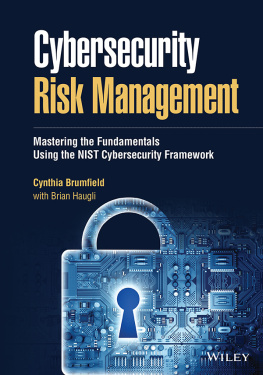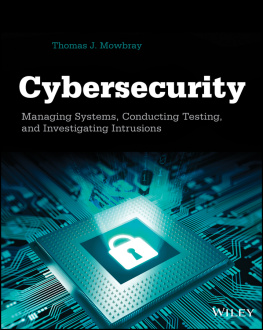
Table of Contents
List of Tables
- Chapter 8
- Chapter 11
- Chapter 15
List of Illustrations
- Chapter 4
- Chapter 8
- Chapter 9
- Chapter 12
- Chapter 17
- Chapter 19
- Chapter 20
Guide
Pages
You CAN Stop Stupid
Stopping Losses from Accidental and Malicious Actions
Ira Winkler
Dr. Tracy Celaya Brown

Introduction
We believe that the title of a book is perhaps its most critical characteristic. We acknowledge that the title, You Can Stop Stupid is controversial. We had considered other possible titles, such as Stopping Human Attacks, but such a title does not convey the essence of this book. Although we do intend to stop attacks that target your users, the same methodology will stop attacks by malicious insiders, as well as accidents.
The underlying problem is not that users are the targets of attacks or that they accidentally or maliciously create damage, but that users have the ability to make decisions or take actions that inevitably lead to damage.
That is the fundamental issue this book addresses, and it makes a critical distinction: The problem lies not necessarily in the user, but also in the environment surrounding the people performing operational functions.
What Is Stupid?
Managers, security specialists, IT staff, and other professionals often complain that employees, customers, and users are stupid. But what is stupid? The definition of stupid is having or showing a great lack of intelligence or common sense.
First, let's examine the attribute of showing a great lack of intelligence. When your organization hires and reviews people, you generally assess whether they have the requisite intelligence to perform the required duties. If you did hire or retain an employee knowing that they lacked the necessary intelligence to do the job, who is actually stupid in this scenario: the employee or the employer?
Regarding a person who shows a great lack of common sense, there is a critical psychological principle regarding common sense: You cannot have common sense without common knowledge. Therefore, someone who is stupid for demonstrating a great lack of common sense is likely suffering from a lack of common knowledge. Who is responsible for ensuring that the person has such common knowledge? That responsibility belongs to the people who place or retain people in positions within the organization.
In general, don't accuse someone in your organization of being stupid. Instead, identify and adjust your own failings in bad employment or training practices, as well as the processes and technologies that enable the stupidity.
Do You Create Stupidity?
When people talk about employee, customer, and other user stupidity, they are often thinking of the actions those users take that cause damage to your organization. In this book, we refer to that as user-initiated loss (UIL). The simple fact is that a user can't initiate loss unless an organization creates an environment that puts them in a position to do so. While organizations do have to empower employees, customers, and other users to perform their tasks, in most environments, there is little thought paid to proactively reducing UIL.
It is expected that users will make mistakes, fall for tricks, or purposefully intend to cause damage. An organization needs to consider this in its specification of business practices and technological environments to reduce the potential for user-initiated loss.
Even if you reduce the likelihood for people to cause harm, you cannot eliminate all possibilities. There is no such thing as perfect security, so it is folly to rely completely on prevention. For that reason, wise organizations also embed controls to detect and reduce damage throughout their business processes.
How Smart Organizations Become Smart
Consider that large retail stores, such as Target, have a great deal to lose from a physical standpoint. Goods can be physically stolen. Cashiers can potentially steal money. These are just a couple of common forms of loss in retail environments.
To account for the theft of goods, extensive security controls are in place. Cameras monitor areas where goods are delivered, stored, and sold. Strict inventory control systems track everything. Store associates are rewarded for reporting potential shoplifters. Security guards, sometimes undercover, patrol the store. High-value goods are outfitted with sensors, and sensor readers are stationed at the exits.
From a cash perspective, cashiers receive and return their cash drawers in a room that is heavily monitored. They have to count in the cash and verify the cash under the watchful eyes of the surveillance team. The cash registers keep track of and report all transactions. Accounting teams also verify that all cash receipts are within a reasonable level of expected error. Also, as important, the use of credit cards reduces the opportunity for employees to mishandle or steal cash.
Despite all of these measures, there are still losses. Some loss is due to simple errors. A cashier might accidentally give out the wrong change. There might be a simple accounting error. Employees might figure out how to game the system and embezzle cash. Someone in the self-checkout line might accidentally not scan all items. Criminals may still be able to outright steal goods despite the best controls. Regardless, the controls proactively mitigate and detect large amounts of losses. There are likely further opportunities for mitigating loss, and new studies can always be consulted to determine varying degrees to which they might be practical.
An excellent example of an industry that intelligently mitigates risk is the scuba diving industry. Author Ira Winkler is certified as a Master Scuba Diving Trainer and first heard the expression you can't stop stupid during his scuba instructor training. The instructor was telling all the prospective instructors that there will always be some students who do not pay attention to safety rules. It is true that scuba diving provides for an almost infinite number of ways for students to do something potentially dangerous and even deadly.
Despite this, scuba diving is statistically safer than bowling. When you consider how that may be, you have to understand that most scuba instruction involves safety protocols. Reputable dive operators are affiliated with professional associations, such as the Professional Association of Diving Instructors (PADI). PADI examines how dive accidents have occurred and works with members to develop safety protocols that all members must follow.
For example, when Ira would certify new divers, all students had to take course work specifying safe diving practices. They also had to go through a health screening process and demonstrate basic swimming skills and comfort in the water. They then had to demonstrate the required diving skills in a pool.
When it comes to certifying people in open water, all equipment is inspected by the students and instructors prior to diving. The potential dive location is chosen based upon the calmness and clarity of the water and limited depth so that students don't accidentally go too deep. Before the dive, there is a complete dive briefing, so students know what to expect, as well as safety precautions and instructions about what to do if a diver runs into trouble. The instructors are familiar with the location and any potential hazards. The number of students is limited, and dive master assistants accompany the group as available to ensure safety. Additionally, instructors are required to ensure there is a well-equipped first aid kit, an emergency oxygen supply, and information about the nearest hospital and hyperbaric chamber.
Next page










